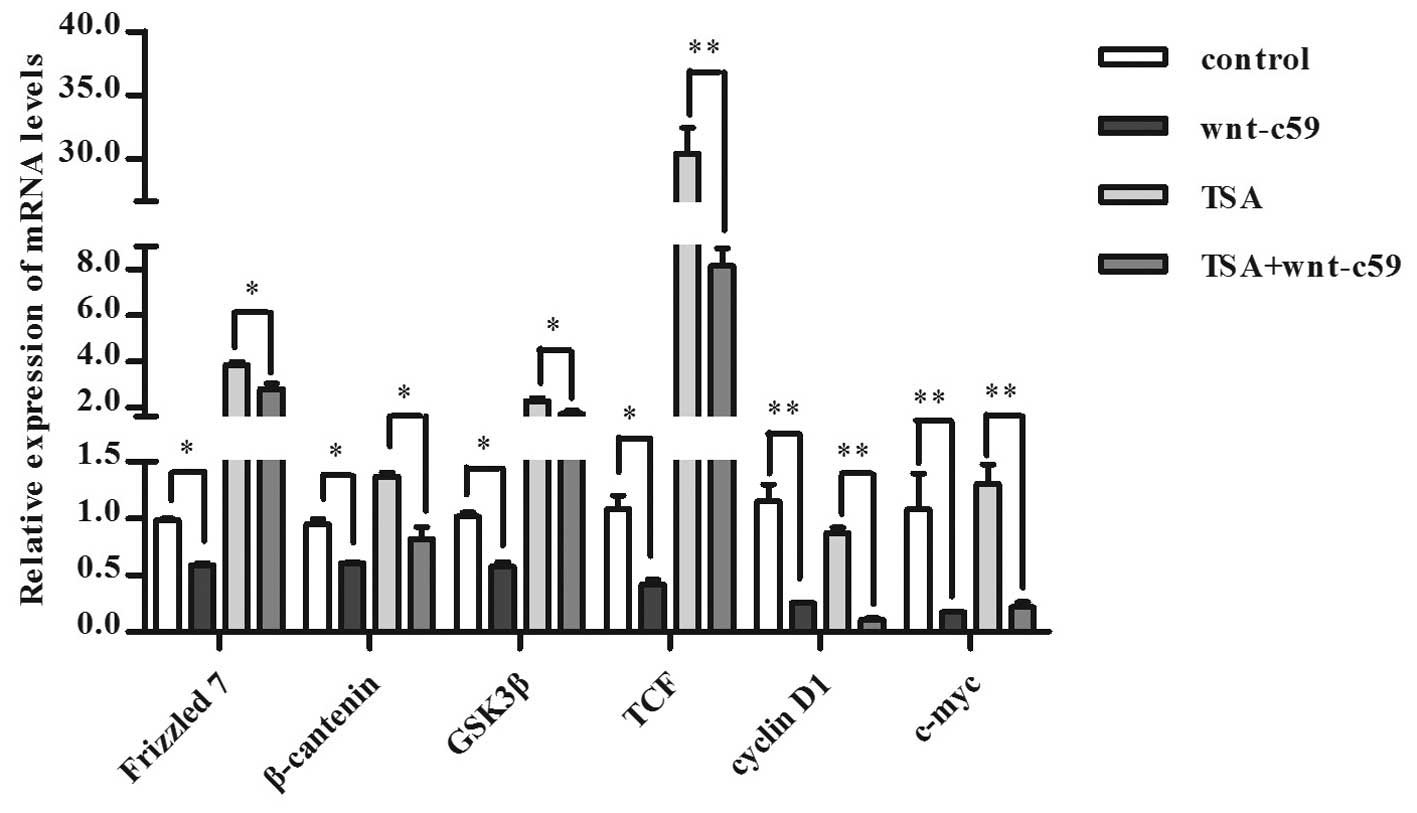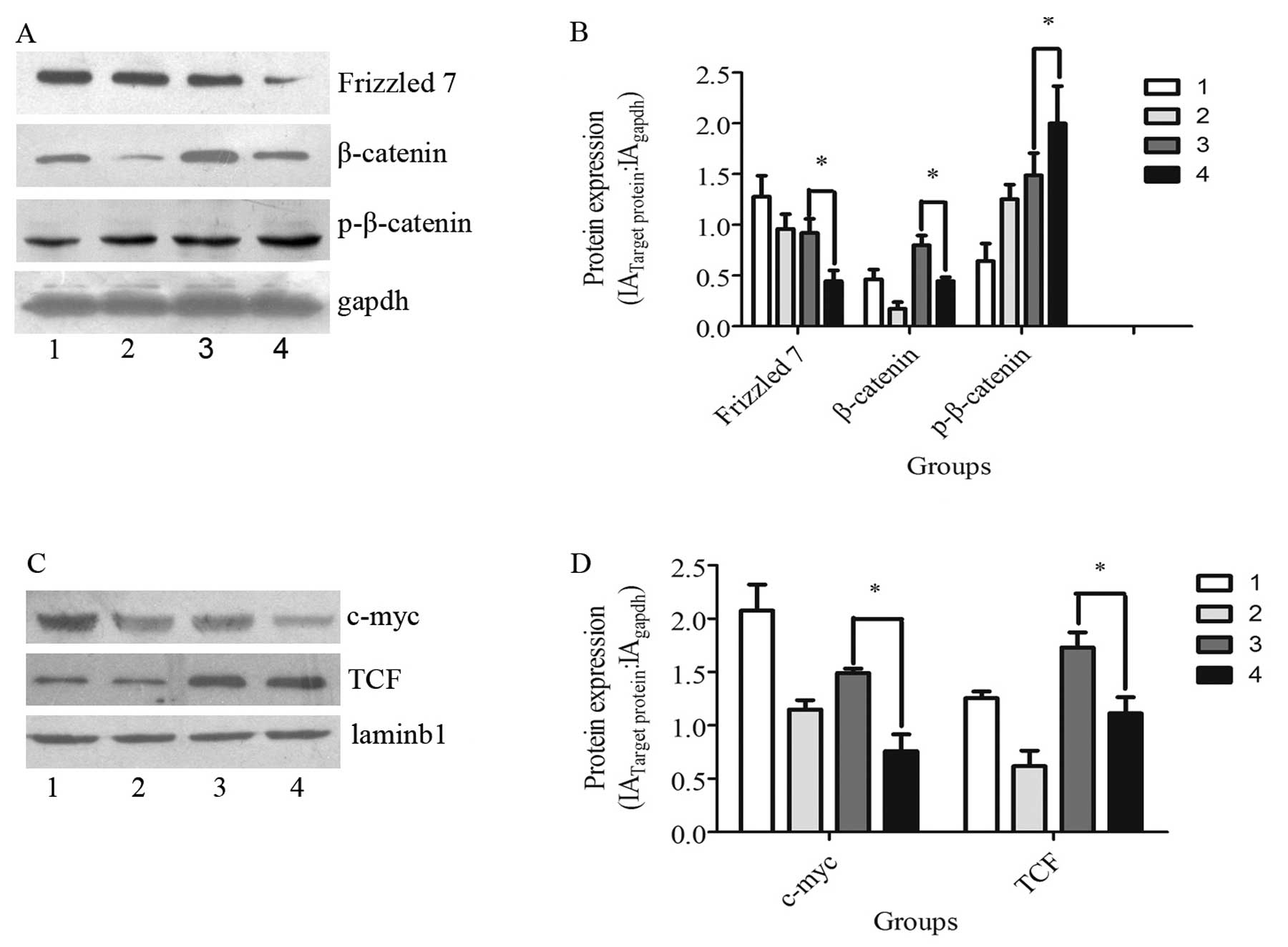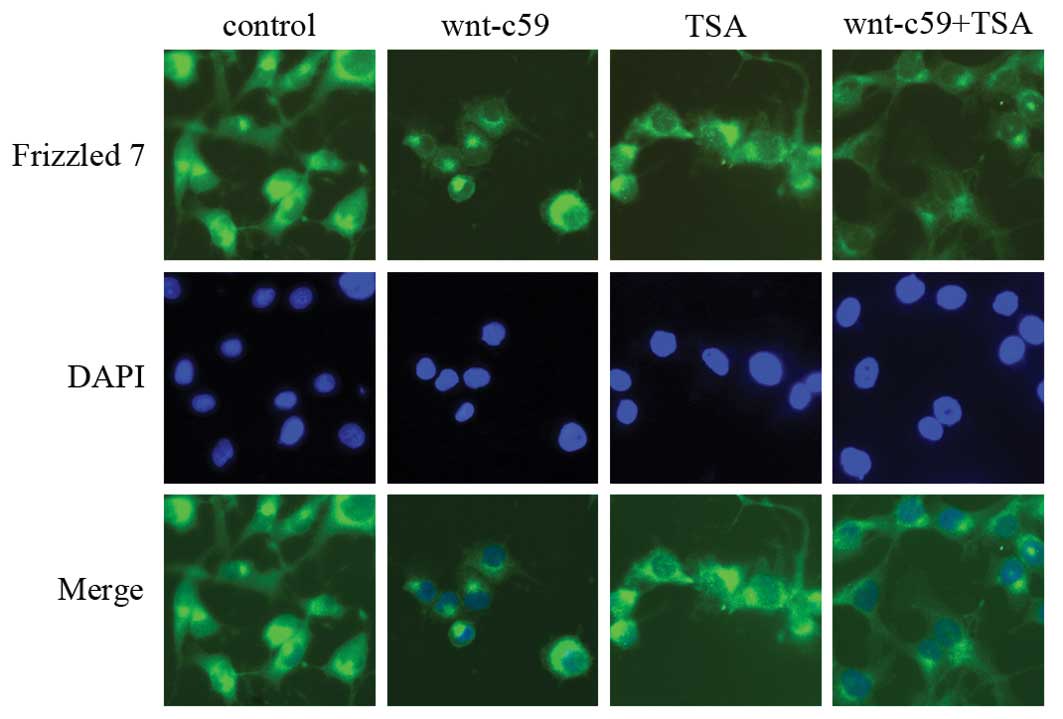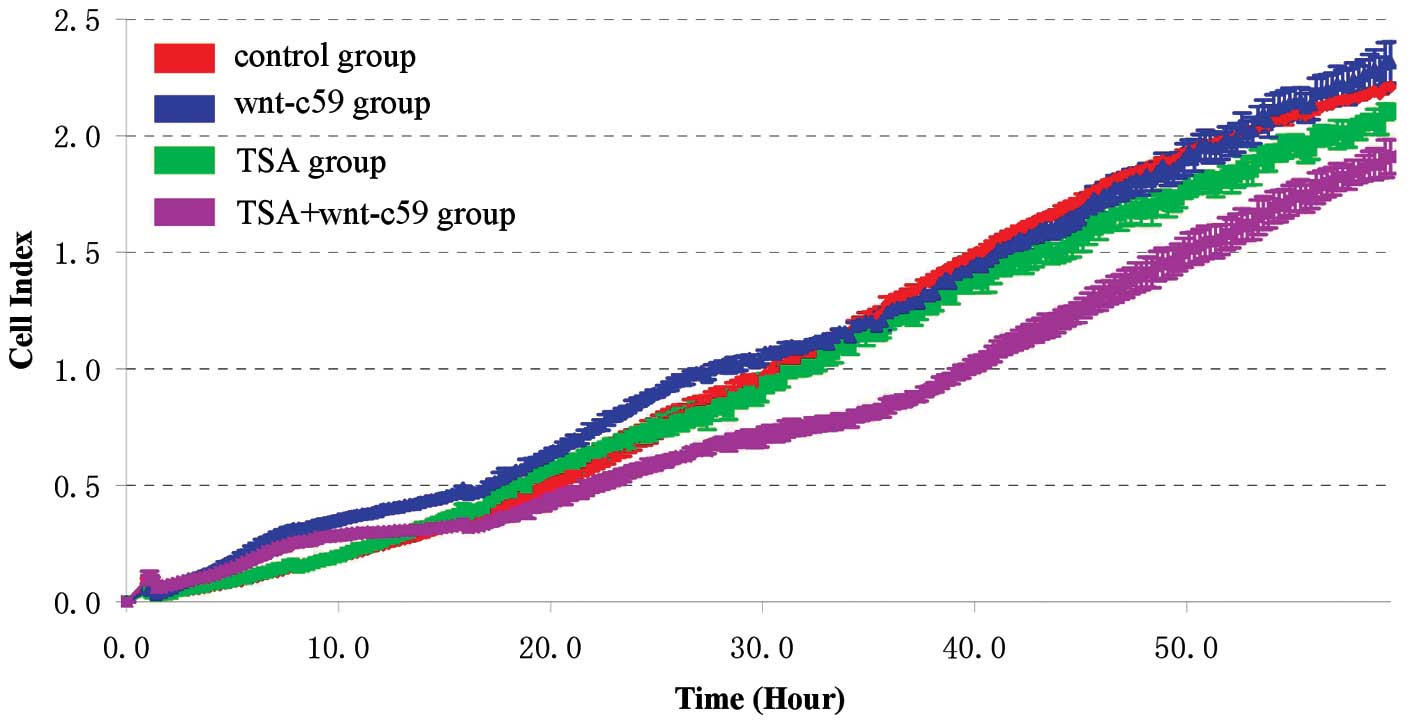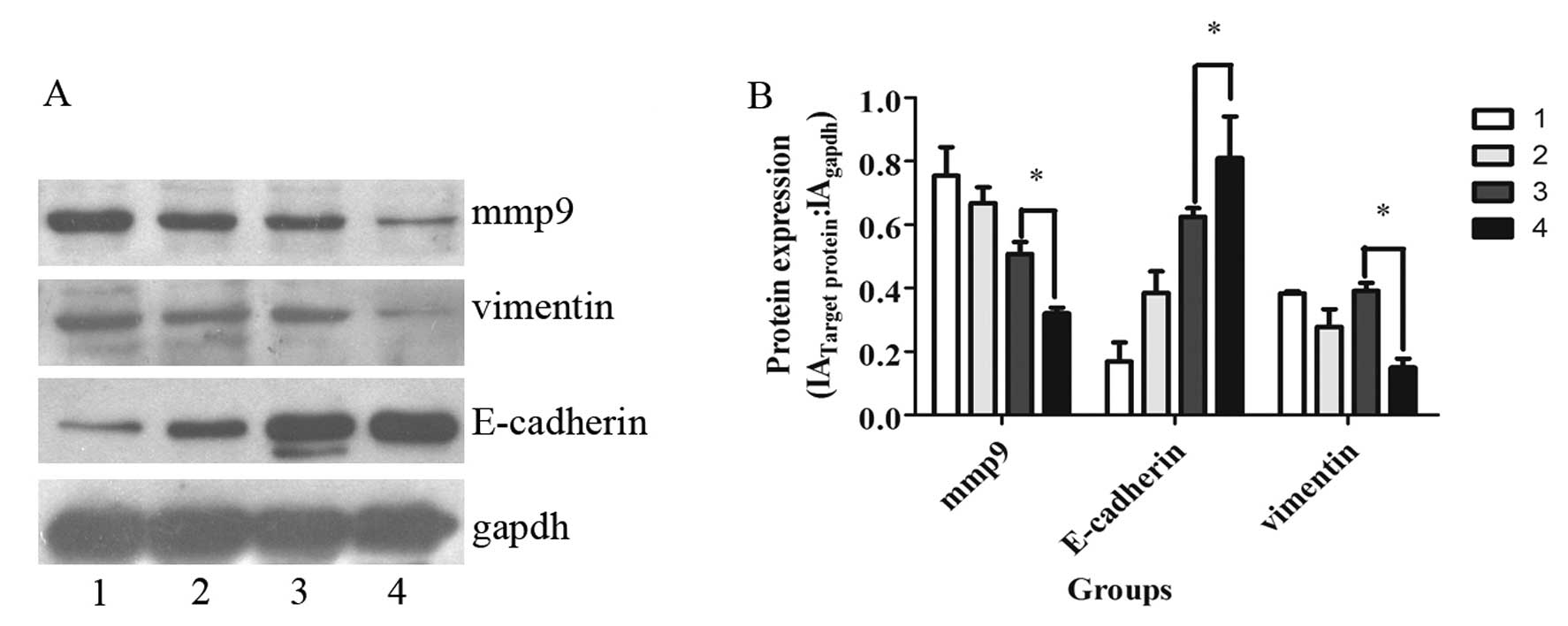|
1
|
Akita H, Doki Y, Miyata H, et al: Clinical
significance of the second cycle response to cisplatin-based
chemotherapy as preoperative treatment for esophageal squamous cell
carcinoma. J Surg Oncol. 93:401–409. 2006. View Article : Google Scholar : PubMed/NCBI
|
|
2
|
Badiglian Filho L, Oshima CT, De Oliveira
Lima F, et al: Canonical and noncanonical Wnt pathway: a comparison
among normal ovary, benign ovarian tumor and ovarian cancer. Oncol
Rep. 21:313–320. 2009.PubMed/NCBI
|
|
3
|
Batova A, Shao LE, Diccianni MB, et al:
The histone deacetylase inhibitor AN-9 has selective toxicity to
acute leukemia and drug-resistant primary leukemia and cancer cell
lines. Blood. 100:3319–3324. 2002. View Article : Google Scholar : PubMed/NCBI
|
|
4
|
Bordonaro M, Tewari S, Cicco CE, Atamna W
and Lazarova DL: A switch from canonical to noncanonical Wnt
signaling mediates drug resistance in colon cancer cells. PLoS One.
6:e273082011. View Article : Google Scholar : PubMed/NCBI
|
|
5
|
Fournel M, Trachy-Bourget MC, Yan PT, et
al: Sulfonamide anilides, a novel class of histone deacetylase
inhibitors, are antiproliferative against human tumors. Cancer Res.
62:4325–4330. 2002.PubMed/NCBI
|
|
6
|
Freese JL, Pino D and Pleasure SJ: Wnt
signaling in development and disease. Neurobiol Dis. 38:148–153.
2010. View Article : Google Scholar : PubMed/NCBI
|
|
7
|
Ganesan A, Nolan L, Crabb SJ and Packham
G: Epigenetic therapy: histone acetylation, DNA methylation and
anti-cancer drug discovery. Curr Cancer Drug Targets. 9:963–981.
2009. View Article : Google Scholar : PubMed/NCBI
|
|
8
|
Gottesman MM, Fojo T and Bates SE:
Multidrug resistance in cancer: role of ATP-dependent transporters.
Nat Rev Cancer. 2:48–58. 2002. View
Article : Google Scholar : PubMed/NCBI
|
|
9
|
Greenhalf W and Thomas A: Combination
therapy for the treatment of pancreatic cancer. Anticancer Agents
Med Chem. 11:418–426. 2011. View Article : Google Scholar : PubMed/NCBI
|
|
10
|
Griesmann H, Ripka S, Pralle M, et al:
WNT5A-NFAT signaling mediates resistance to apoptosis in pancreatic
cancer. Neoplasia. 15:11–22. 2013.PubMed/NCBI
|
|
11
|
Grimm M, Lazariotou M, Kircher S, et al:
MMP-1 is a (pre-)invasive factor in Barrett-associated esophageal
adenocarcinomas and is associated with positive lymph node status.
J Transl Med. 8:992010. View Article : Google Scholar : PubMed/NCBI
|
|
12
|
Hidalgo M and von Hoff DD: Translational
therapeutic opportunities in ductal adenocarcinoma of the pancreas.
Clin Cancer Res. 18:4249–4256. 2012. View Article : Google Scholar : PubMed/NCBI
|
|
13
|
Hong Y, Yang J, Wu W, et al: Knockdown of
BCL2L12 leads to cisplatin resistance in MDA-MB-231 breast cancer
cells. Biochim Biophys Acta. 1782:649–657. 2008. View Article : Google Scholar : PubMed/NCBI
|
|
14
|
Hung CC and Liou HH: YC-1, a novel
potential anticancer agent, inhibits multidrug-resistant protein
via cGMP-dependent pathway. Invest New Drugs. 29:1337–1346. 2011.
View Article : Google Scholar : PubMed/NCBI
|
|
15
|
Inman GJ, Nicolas FJ, Callahan JF, et al:
SB-431542 is a potent and specific inhibitor of transforming growth
factor-beta superfamily type I activin receptor-like kinase (ALK)
receptors ALK4, ALK5, and ALK7. Mol Pharmacol. 62:65–74. 2002.
View Article : Google Scholar : PubMed/NCBI
|
|
16
|
Kornmann M, Danenberg KD, Arber N, Beger
HG, Danenberg PV and Korc M: Inhibition of cyclin D1 expression in
human pancreatic cancer cells is associated with increased
chemosensitivity and decreased expression of multiple
chemoresistance genes. Cancer Res. 59:3505–3511. 1999.
|
|
17
|
Le X, Shi Q, Wang B, et al: Molecular
regulation of constitutive expression of interleukin-8 in human
pancreatic adenocarcinoma. J Interferon Cytokine Res. 20:935–946.
2000. View Article : Google Scholar : PubMed/NCBI
|
|
18
|
Li Y, Van den Boom TG II, Kong D, et al:
Up-regulation of miR-200 and let-7 by natural agents leads to the
reversal of epithelial-to-mesenchymal transition in
gemcitabine-resistant pancreatic cancer cells. Cancer Res.
69:6704–6712. 2009. View Article : Google Scholar
|
|
19
|
Liu X, Mazanek P, Dam V, et al:
Deregulated Wnt/beta-catenin program in high-risk neuroblastomas
without MYCN amplification. Oncogene. 27:1478–1488. 2008.
View Article : Google Scholar : PubMed/NCBI
|
|
20
|
Liu Yong FY and Hui Wang: Synergistic
augmentation of cisplatin-induced apoptosis in HeLa cells by
rapamycin. Central China Med J. 33:300–303. 2009.
|
|
21
|
Livak KJ and Schmittgen TD: Analysis of
relative gene expression data using real-time quantitative PCR and
the 2(-Delta Delta C(T)) method. Methods. 25:402–408. 2001.
View Article : Google Scholar : PubMed/NCBI
|
|
22
|
Long J, Zhang Y, Yu X, et al: Overcoming
drug resistance in pancreatic cancer. Expert Opin Ther Targets.
15:817–828. 2011. View Article : Google Scholar : PubMed/NCBI
|
|
23
|
Loos M, Kleeff J, Friess H and Büchler MW:
Surgical treatment of pancreatic cancer. Ann NY Acad Sci.
1138:169–180. 2008. View Article : Google Scholar : PubMed/NCBI
|
|
24
|
Masckauchan TN, Shawber CJ, Funahashi Y,
Li CM and Kitajewski J: Wnt/beta-catenin signaling induces
proliferation, survival and interleukin-8 in human endothelial
cells. Angiogenesis. 8:43–51. 2005. View Article : Google Scholar : PubMed/NCBI
|
|
25
|
McCubrey JA, Steelman LS, Abrams SL, et
al: Roles of the RAF/MEK/ERK and PI3K/PTEN/AKT pathways in
malignant transformation and drug resistance. Adv Enzyme Regul.
46:249–279. 2006. View Article : Google Scholar : PubMed/NCBI
|
|
26
|
Mellor HR and Callaghan R: Resistance to
chemotherapy in cancer: a complex and integrated cellular response.
Pharmacology. 81:275–300. 2008. View Article : Google Scholar : PubMed/NCBI
|
|
27
|
Mimeault M, Hauke R and Batra SK: Recent
advances on the molecular mechanisms involved in the drug
resistance of cancer cells and novel targeting therapies. Clin
Pharmacol Ther. 83:673–691. 2008. View Article : Google Scholar : PubMed/NCBI
|
|
28
|
Mimeault M, Johansson SL, Senapati S, Momi
N, Chakraborty S and Batra SK: MUC4 down-regulation reverses
chemoresistance of pancreatic cancer stem/progenitor cells and
their progenies. Cancer Lett. 295:69–84. 2010. View Article : Google Scholar : PubMed/NCBI
|
|
29
|
Moore PS, Barbi S, Donadelli M, et al:
Gene expression profiling after treatment with the histone
deacetylase inhibitor trichostatin A reveals altered expression of
both pro- and anti-apoptotic genes in pancreatic adenocarcinoma
cells. Biochim Biophys Acta. 1693:167–176. 2004. View Article : Google Scholar
|
|
30
|
Nakagami H, Soukupova H, Schikora A,
Zarsky V and Hirt H: A Mitogen-activated protein kinase mediates
reactive oxygen species homeostasis in Arabidopsis. J Biol Chem.
281:38697–38704. 2006. View Article : Google Scholar : PubMed/NCBI
|
|
31
|
Neoptolemos JP, Stocken DD, Bassi C, et
al: Adjuvant chemotherapy with fluorouracil plus folinic acid vs
gemcitabine following pancreatic cancer resection: a randomized
controlled trial. JAMA. 304:1073–1081. 2010. View Article : Google Scholar
|
|
32
|
Osborn MT and Chambers TC: Role of the
stress-activated/c-Jun NH2-terminal protein kinase pathway in the
cellular response to adriamycin and other chemotherapeutic drugs. J
Biol Chem. 271:30950–30955. 1996. View Article : Google Scholar
|
|
33
|
Qiao Q, Ramadani M, Gansauge S, Gansauge
F, Leder G and Beger HG: Reduced membranous and ectopic cytoplasmic
expression of beta-catenin correlate with cyclin D1 overexpression
and poor prognosis in pancreatic cancer. Int J Cancer. 95:194–197.
2001. View Article : Google Scholar : PubMed/NCBI
|
|
34
|
Rocchi E, Khodjakov A, Volk EL, et al: The
product of the ABC half-transporter gene ABCG2 (BCRP/MXR/ABCP) is
expressed in the plasma membrane. Biochem Biophys Res Commun.
271:42–46. 2000. View Article : Google Scholar : PubMed/NCBI
|
|
35
|
Sayat R, Leber B, Grubac V, Wiltshire L
and Persad S: O-GlcNAc-glycosylation of beta-catenin
regulates its nuclear localization and transcriptional activity.
Exp Cell Res. 314:2774–2787. 2008. View Article : Google Scholar
|
|
36
|
Shah AN, Summy JM, Zhang J, Park SI,
Parikh NU and Gallick GE: Development and characterization of
gemcitabine-resistant pancreatic tumor cells. Ann Surg Oncol.
14:3629–3637. 2007. View Article : Google Scholar : PubMed/NCBI
|
|
37
|
Siegel R, Ward E, Brawley O and Jemal A:
Cancer statistics, 2011: the impact of eliminating socioeconomic
and racial disparities on premature cancer deaths. CA Cancer J
Clin. 61:212–236. 2011. View Article : Google Scholar : PubMed/NCBI
|
|
38
|
Su HY, Lai HC, Lin YW, et al: Epigenetic
silencing of SFRP5 is related to malignant phenotype and
chemoresistance of ovarian cancer through Wnt signaling pathway.
Int J Cancer. 127:555–567. 2010. View Article : Google Scholar : PubMed/NCBI
|
|
39
|
Vaccaro V, Melisi D, Bria E, et al:
Emerging pathways and future targets for the molecular therapy of
pancreatic cancer. Expert Opin Ther Targets. 15:1183–1196. 2011.
View Article : Google Scholar : PubMed/NCBI
|
|
40
|
van Hinsbergh VW, Engelse MA and Quax PH:
Pericellular proteases in angiogenesis and vasculogenesis.
Arterioscler Thromb Vasc Biol. 26:716–728. 2006.PubMed/NCBI
|
|
41
|
Wang Z, Li Y, Kong D, et al: Acquisition
of epithelial-mesenchymal transition phenotype of
gemcitabine-resistant pancreatic cancer cells is linked with
activation of the notch signaling pathway. Cancer Res.
69:2400–2407. 2009. View Article : Google Scholar
|
|
42
|
Yao J, Cai HH, Wei JS, et al: Side
population in the pancreatic cancer cell lines SW1990 and CFPAC-1
is enriched with cancer stem-like cells. Oncol Rep. 23:1375–1382.
2010.PubMed/NCBI
|
|
43
|
Yochum GS, Sherrick CM, Macpartlin M and
Goodman RH: A beta-catenin/TCF-coordinated chromatin loop at MYC
integrates 5′ and 3′ Wnt responsive enhancers. Proc Natl Acad Sci
USA. 107:145–150. 2010.PubMed/NCBI
|
|
44
|
Yuan RH, Jeng YM, Hu RH, et al: Role of
p53 and β-catenin mutations in conjunction with CK19 expression on
early tumor recurrence and prognosis of hepatocellular carcinoma. J
Gastrointest Surg. 15:321–329. 2011.
|



